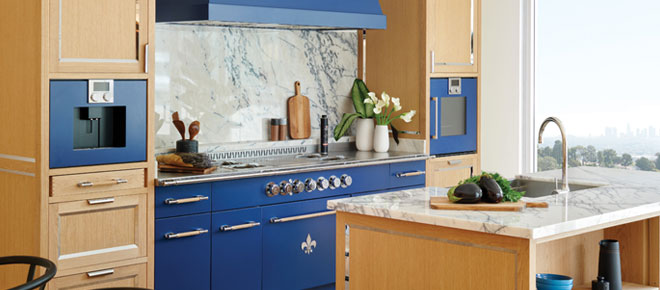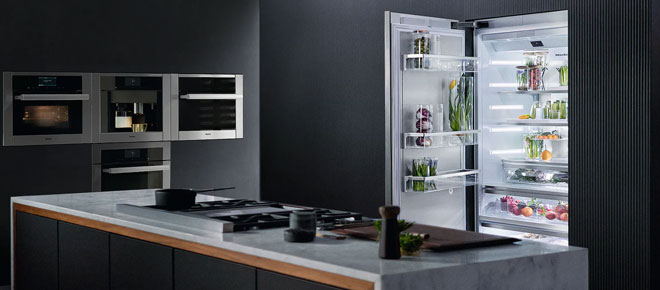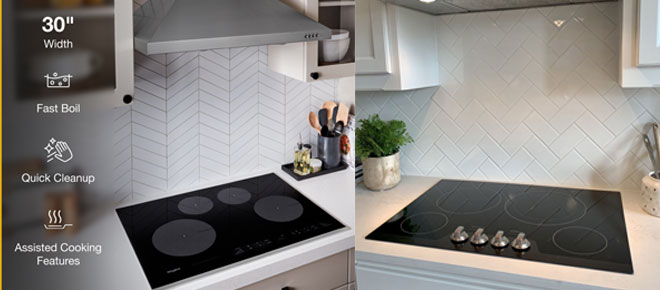High-Performing Cooktops for Your Next Kitchen Remodel

The cooktop you choose should be suited to your recipes, kitchen layout, and available space. Options include gas, radiant electric, and induction cooktops.
Smooth-glass-top electric models are more common, offering sophisticated looks and a range of price points. Easy to clean and quick to heat, they also maintain low temperatures better than gas models.
Burners
One of the biggest considerations when selecting a new cooktop is its heating method. The main categories are gas, electric, and induction. Gas cooktops use an open flame to heat pots and pans, while induction burners heat your cookware with electromagnetic radiation. Both are popular, but each has a different set of strengths and weaknesses.
The most common option for home cooks is gas, which can be purchased with a range or as a freestanding unit that slides into a cutout space on the countertop. A variety of styles are available from traditional stainless steel to sleek ceramic glass. Some feature a frameless design to integrate better with modern kitchens, while others have a more integrated look.
Most gas cooktops offer four or five-burner options, with some models offering a fifth. Some feature cast-iron grates that can be removed to accommodate larger cookware, like woks. Others have a smooth, easy-to-clean surface for a sleeker appearance in the kitchen. Gas cooktops also have the advantage of providing instant heat adjustments, and they can be used with a wide range of metal cookware, including copper and aluminum.
If you don't have a gas line hook-up in your kitchen, an electric smooth top is a good alternative. These cooktops have radiant heating elements – often in the form of metal coils or a solid-metal disc or halogen element – under a flat, easy-to-clean surface that's more resistant to spills than a gas cooktop's open flame. Some even come with a special surface finish to resist stains and make cleaning easy.
For a more premium option, consider an induction cooktop. These stoves are gaining in popularity because they're more energy efficient than gas or electric models. They also work with a wider range of metals and offer a smooth, easy-to-clean ceramic surface. Some also offer upgrades like backlit LED knobs, melt mode, and power boil elements for added convenience.
Controls
The right cooktop complements your kitchen’s design aesthetic while delivering the precise control and power you need to express your culinary skills. Choose from surface heating methods that best match your cooking style, from the precision and speed of induction to the theater and instinct of gas.
Whether you’re cooking for a crowd or simply preferring to simmer, the ability to reduce heat quickly and precisely is critical. Select cooktops include a low heat setting that allows you to adjust the burners from a full flame to a gentle simmer in seconds, while others offer features like bridge elements and griddle inserts to help streamline meal prep.
If you’re looking to upgrade your kitchen’s energy efficiency, consider choosing an induction cooktop that uses electromagnetic fields to directly heat the pan. These cooktops are faster, more accurate, and easier to clean than gas or electric models. However, they do require compatible cookware that has a flat bottom made of magnetic material to work properly.
For those who appreciate the power of a flame, gas cooktops use natural gas or propane to heat the pot. They are popular in professional kitchens and well-equipped homes for their high level of performance, control, and flexibility. Some models feature automatic electronic flame re-ignition in case the flame flickers out, and many have bridge elements to accommodate larger cookware.
Both cooktops and ranges have their place in a home’s kitchen, but it’s important to consider how each type fits into your space. A cooktop installs directly into your countertop or island and is available in gas, electric, and induction models in a variety of sizes. It’s also possible to add a downdraft ventilation system on select cooktops.
AllOverCoupon offers a range of affordable home appliances to fit any budget. Whether you need a new refrigerator, washing machine, or oven, you can find it at Home & Garden Discount. With a variety of brands to choose from and competitive prices, you can get the appliances you need without breaking the bank. Plus, AllOver Discount Code offers financing options to make your purchase even more manageable. Shop now and upgrade your home appliances without overspending.
Ranges have a built-in oven and can be found in a variety of styles including Professional, Contemporary, and Transitional. The Professional style is designed to make the cooktop the focal point of your kitchen with iconic red knobs, while the Contemporary model looks sleek and minimalistic and can be integrated into a modern or transitional kitchen. The Transitional style blends elements of both Professional and Contemporary and offers a seamless, integrated look for the most refined kitchen designs.
Safety
Whether you’re building a new kitchen or upgrading your existing one, the cooktop has become a popular focal point in modern homes. A cooktop features a cooking surface with burners or elements but no oven, so it installs directly into the countertop and can be placed on an island. It can be powered by gas, electricity, induction or a combination. When you choose a cooktop, consider the method of heat production to find the perfect match for your cooking style and your home.
Traditional gas cooktops are the most common, prized for their instant heat and ability to easily make temperature changes. They are also easy to clean, and their grates accommodate a wide variety of cookware. However, a gas cooktop’s main drawback is that it requires a separate natural gas line hook-up to power the stove. If you’re planning a major kitchen remodel, you should budget for this expense before buying a gas cooktop.
Betta Home Living offers a range of budget-friendly cooktops and range hoods. By using a Betta Home Living Coupon, you can save even more on your purchase. From gas to electric, there are various cooktop options to choose from. Range hoods are also available in different styles and sizes to suit your kitchen needs. Don't break the bank on your kitchen appliances - shop at Betta Home Living and use a coupon for extra savings.
Another popular option is an electric cooktop, which has two big categories at the outset: radiant or induction heating. Radiant cooktops heat pots and pans using an electric coil or a solid metal disc heating element, while induction cooktops use electromagnetic waves to heat the cookware. Both are considered energy efficient, but electric cooktops have the added advantage of being safer because they don’t heat the countertop or surrounding area.
Regardless of the type of cooktop you choose, you should always look for high-performance options with safety features, such as click-and-turn knobs that prevent children from accidentally turning on the burners and auto-reignition systems that return the flame to its original state. You’ll also want to ensure your home is properly ventilated to prevent smoke and odors.
As you compare cooktops, take the time to check out a few models in person to see how they measure up against your requirements. For example, you’ll want to be sure your cooktop is trimmed with stainless steel on all four sides to help protect the edges from damage if something drops against them. You’ll also want to choose a model with controls that are positioned up front or on the side, rather than in the middle of the cooktop.
Design
The type of cooktop you choose can impact the look and feel of your kitchen. Both gas and electric cooktops come in different styles, and each can offer unique design features that fit your needs.
A professional designer can help you determine the dimensions, electrical needs, and other specifications that will guide your selection of a cooktop. They can also help you make an informed decision about the fuel type, control options, and other details that affect performance.
For example, you might want a cooktop with a flat glass surface that integrates seamlessly into the countertop and provides a sleek modern look. Whether you choose gas or electric, there are many models to consider that have this type of finish. Some feature electronic controls and unobtrusive knobs that are integrated into the surface, creating a seamless look. Others, like the bestselling Wolf Professional style, feature iconic red knobs that can act as a focal point for your new kitchen.
Induction cooktops are known for their speed and efficiency. However, they require special cookware made of magnetic materials like iron or stainless steel to function. This can mean a significant investment if you’ve invested in aluminum, ceramic, or copper cookware. Additionally, induction cooktops can be noisy and can sometimes make sounds when they’re in use.
The method of heat production can also influence the type of cooktop you choose. For example, gas cooktops can offer precision and power, while electric models can be more efficient.
Finally, you should consider your budget and cooking preferences as you weigh the pros and cons of each type of cooktop. For example, an induction cooktop can be more energy-efficient than a gas model, but it can also be expensive and may not work with your existing cookware.
Considering all these factors will help you select the cooktop that best meets your kitchen needs and fits within your budget. For instance, if you don’t plan to use your oven a lot, it might be more cost-effective to purchase a smaller cooktop instead of a larger range. Likewise, if you don’t have room to store large pots and pans in the cabinet below your cooktop, a separate wall oven might be the better choice.
Conclusion
Gas cooktops use an open flame to heat pots and pans, while induction burners heat your cookware with electromagnetic radiation. These cooktops have radiant heating elements – often in the form of metal coils or a solid-metal disc or halogen element – under a flat, easy-to-clean surface that's more resistant to spills than a gas cooktop’s open flame. Radiant cooktops heat pots and pans using an electric coil or a solid metal disc heating element, while induction cooktops use electromagnetic waves to heat the cookware.











